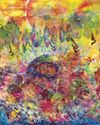
It can be illuminating to bring resources and insights from other aesthetic traditions into the debates of Western philosophy. I want to introduce the philosophy of Japanese gardens, in an attempt to widen our pool of intellectual thought, primarily in the field of aesthetics, broadening the way in which we think about formal properties in analytic philosophy. I want to look briefly at how the Japanese tradition highlights our affinity to natural objects, the importance of the empathy we bestow upon them, and the idea that small can, indeed, is beautiful. I will use the following definitions: first, ‘natural objects’ are those which exist organically, independent of human interaction, for example, a conifer cone; second, an ‘aesthetic experience’ is one which is pleasurable for the observer as a result of any given perceivable property of the object perceived.
Since the seventeenth century, we have been intrigued by the size of living things. That was when Robert Hooke’s illustrated book Micrographia (1665) first allowed the general public to have visual access to the field of microscopy, to study objects which cannot be seen with the naked eye, such as onion cells or flea anatomy. In the art-historical dimension, the invention of the doll’s house also provoked a fascination with miniatures.
This story is from the October/November 2021 edition of Philosophy Now.
Start your 7-day Magzter GOLD free trial to access thousands of curated premium stories, and 9,000+ magazines and newspapers.
Already a subscriber ? Sign In
This story is from the October/November 2021 edition of Philosophy Now.
Start your 7-day Magzter GOLD free trial to access thousands of curated premium stories, and 9,000+ magazines and newspapers.
Already a subscriber? Sign In

Metaphors & Creativity
Ignacio Gonzalez-Martinez has a flash of inspiration about the role metaphors play in creative thought.

Medieval Islam & the Nature of God
Musa Mumtaz meditates on two maverick medieval Muslim metaphysicians.

Robert Stern
talks with AmirAli Maleki about philosophy in general, and Kant and Hegel in particular.

Volney (1757-1820)
John P. Irish travels the path of a revolutionary mind.

IT'S A WONDERFUL LIFE
Becky Lee Meadows considers questions of guilt, innocence, and despair in this classic Christmas movie.

"I refute it thus"
Raymond Tallis kicks immaterialism into touch.

Cave Girl Principles
Larry Chan takes us back to the dawn of thought.

A God of Limited Power
Philip Goff grasps hold of the problem of evil and comes up with a novel solution.

A Critique of Pure Atheism
Andrew Likoudis questions the basis of some popular atheist arguments.

Exploring Atheism
Amrit Pathak gives us a run-down of the foundations of modern atheism.